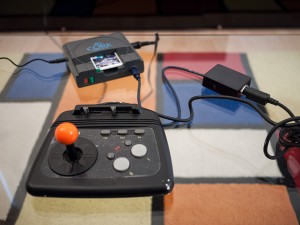While consoles that accept standard C7 plugs are convenient, no need to keep track of unique power bricks, there is always the danger in 230V countries of plugging a 110V console directly into the mains. Unfortunately this happened to my Japanese Dreamcast. Fortunately the only damage was a blown fuse in the power supply, which can be replaced.
Archives
All posts by vrai
From the Spectrum 128K+ onwards all Spectrums were capable of generating RGB output via the “monitor” socket. This makes connecting them to modern televisions extremely easy. Unfortunately the earlier models only possessed a RF output. This produces the worst possible output and increasingly few displays can demodulate analogue television signals. Luckily the design of the Spectrum makes it very easy to convert the RF output in to a simple composite out.
The Dragon 32 (aka the Welsh Tandy TRS-80 Color Computer clone) has many features that were advanced for its time. Unfortunately amongst these are two analogue joystick ports. Capable of six-bit resolution on each axis they are quite nice, except for playing games with. The vast majority of Dragon 32/TRS-80 games were ports from other systems and designed for digital controls. Luckily it’s possible to create an adapter that allows digital controls to be used with the Dragon 32. Very luckily in fact; as it’s basically impossible to find a working Dragon 32 analogue joystick these days.
A working Famicom Disk System is one of the pinnacles of retro console collectibility and even if one does acquire a good example it’s only a matter of time before it reverts back to its natural state of brokenness. Luckily it’s possible to replace the most fragile part of the FDS – the drive itself – with a PC and play games on original hardware, but without the inherent fragility of a twenty-five year old floppy disk drive.
Unlike the majority of consumer products, consoles tends to peak with the initial release. The first generation Playstation, PS2, PS3, Genesis and Master System were all superior to the cost reduction models that followed them. Indeed the NES, while possessing composite output, lacked the disk system support and FM sound provided by the original Famicom. The top-loading NES-101 dropped the composite out, resulting in a machine with only RF output and none of the Famicom’s extra feature set. However the top-loading AV Famicom (the HVC-101) kept the extra FM sound of the original, along with the Famicom Disk System support missing from the western machines, and added composite out via a SNES style AV connector (hence the name). The question is, does the AV Famicom’s composite output match up to the excellent video produced by the NES?
Continue Reading
One of the mysteries of video gaming is why manufacturers insist on taking perfectly good Japanese games consoles and redesigning them for the US and (less frequently) other markets. One particularly puzzling example is the NEC PC Engine. A small and sleek unit in Japan, it doubled in size for the US release and became the poorly spelt Turbo Grafx 16. As well as enlarging the console, NEC also saw fit to replace the mini-DIN plug used by the PC Engine controller with a full sized (though thankfully still standard) DIN. This meant and adapter was required to use PC Engine peripherals on the TG16 and vice-versa. However while the former was produced and is still available; the latter seems either never to have been manufactured or it was made in such small quantities that none are available today.
